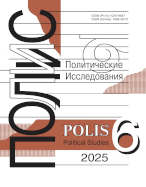The view of offensive realism and liberalism on U.S. foreign policy
Borovsky Yu.V.,
MGIMO University, Moscow, Russia, yuribor@mail.ru
elibrary_id: 278990 | ORCID: 0000-0001-8855-5147 | RESEARCHER_ID: AAE-7582-2019
Article received: 2023.03.02. Accepted: 2023.06.28

DOI: 10.17976/jpps/2024.01.03
EDN: EBGOHG
Borovsky Yu.V. The view of offensive realism and liberalism on U.S. foreign policy. – Polis. Political Studies. 2024. No. 1. https://doi.org/10.17976/jpps/2024.01.03. EDN: EBGOHG (In Russ.)
Since the end of the Cold War, the United States of America has pursued an offensive foreign policy. In the realities of the 2010s and 2020s, marked by mounting resistance to American global dominance, primarily from Russia and China, there are prerequisites for the adjustment of the U.S. foreign policy strategy. The aim of the article is to identify the underlying causes of offensiveness in U.S. foreign policy of the post–bipolar period based on theoretical constructs of offensive realism and liberalism. Research has shown that offensive realism and offensive liberalism can help understand the offensive nature of U.S. foreign policy after 1991 in their own way and make appropriate projections for the future. Based on the tenets of offensive realism, it can be assumed that the collapse of the Soviet Union and communism have created an enabling environment for maximizing the power of the United States, which Washington could not but leverage. Witnessing the dwindling U.S. power potential, as well as the strengthening of China and Russia in the 2010s – 2020s, Washington has not stopped acting in the logic of offensive realism, but under the Trump and Biden administrations it has definitely began to move towards defensive realism. As the rivals to the US continue to strengthen their capacities, this trend can only intensify. Following the tenets of offensive liberalism, it is possible to assume that after the Cold War, the power of the United States has turned out to be so great in comparison with other great and major powers that Washington has begun to offensively build an American liberal hegemony, letting power rivalry falls by the wayside. However, due to the weakening of the U.S. power potential, as well as the simultaneous rise of China and Russia, it has been forced to begin a transition to a strategy based on offensive and defensive realism under the Trump and Biden administrations. If its rivals continue to rise, the U.S. may turn away from offense altogether.
References
Campbell, B. (2014) Realist or liberal? Theoretical interpretations of the Obama administration’s counterterrorism strategy. International Studies, XIV(2), 31-48.
Elman, C. (2004). Extending offensive realism: the Louisiana purchase and America’s rise to regional hegemony. American Political Science Review, 98(4), 563-576. https://doi.org/10.1017/S0003055404041358
Haass, R. (2010). War of necessity, war of choice: a memoir of two Iraq wars paperback. New York: Simon & Schuster.
Haass, R., & Kupchan, Ch. (2021). The new concert of powers. How to prevent catastrophe and promote stability in a multipolar world. Foreign Affairs. https://www.foreignaffairs.com/articles/world/2021-03-23/ new-concert-powers
Johnson, D., Phil, D., & Thayer, B. (2016). The evolution of offensive realism. Politics the Life Sciences, 35(1), 1-26. https://doi.org/10.1017/pls.2016.6
Kaufman, R.G. (2008). In defense of the Bush doctrine. University press of Kentucky. https://doi.org/10.5810/kentucky/9780813124346.001.0001
Kissinger, G. (1995). Diplomacy. New York: Simon & Schuster.
Kristol, W., & Kagan, R. (1996). Toward a neo-reaganite foreign policy. Foreign Affairs, 75(4), 18-32. https://doi.org/10.2307/20047656
Labs, E.J. (1997). Beyond victory: offensive realism and the expansion of war aims. Security Studies, 6, 1-49. https://doi.org/10.1080/09636419708429321
Layne, C. (1993). The unipolar illusion: why new great powers will rise. International Security, 17, 5-51. https://doi.org/10.2307/2539020
Lobell, S.E. (2010). Structural realism. Offensive and defensive realism. In R.A. Denemark, & R. MarlinBennett (Ed.), International Studies Encyclopedia (pp. 6651-6669). Oxford: Wiley-Blackwell.
Mearsheimer, J.J. (2001). The tragedy of great power politics. New York: W.W. Norton.
Mearsheimer, J.J. (2021). The inevitable rivalry: America, China, and the tragedy of great-power politics. Foreign Affairs, 100(6). https://link.gale.com/apps/doc/A679923063/EAIM?u=anon~8e776aa0&sid=sitem ap&xid=625c8faf
Miller, B. (2010a). Democracy promotion: offensive liberalism versus the rest (of IR theory). Millennium – Journal of International Studies, 38(3), 561-591. https://doi.org/10.1177/0305829810366475
Miller, B. (2010b). Explaining changes in U.S. grand strategy: 9/11, the rise of offensive liberalism, and the war in Iraq. Securities Studies, 19(11), 26-65. https://doi.org/10.1080/09636410903546426
Miller, B., & Rubinovitz, Z. (2020). Between offensive liberalism and defensive realism – four approaches to grand strategy. In Grand Strategy from Truman to Trump (pp. 9-36). Chicago: University of Chicago Press. https://doi.org/10.7208/chicago/9780226735153.003.0002
Nye, J.S. (2012). Obama and smart power. In M. Cox, & D. Stokes (Ed.), US Foreign Policy (pp. 97-109). Oxford: Oxford University Press. https://doi.org/10.1093/hepl/9780199585816.003.0006
Prifti, B. (2014). Continuation in US foreign policy: an offensive realist perspective. USF Tampa graduate theses and dissertations. https://digitalcommons.usf.edu/etd/5384
Rodrik, D., & Walt, S.M. (2022). How to build a better order. Limiting great power rivalry in an anarchic world. Foreign Affairs, 101(5).https://www.foreignaffairs.com/world/build-better-order-great-power-rivalrydani-rodrik-stephen-walt
Singh, R. (2015). ‘defensive liberal wars’: the global war on terror and the return of illiberalism in American foreign policy. Revista de Sociologia e Política, 23(53). https://doi.org/10.1590/1678-987315235306
Smith, N.R., & Dawson, G. (2022). Mearsheimer, realism, and the Ukraine war. Analyse & Kritik, 44(2), https://doi.org/10.1515/auk-2022-2023
Snyder, J. (1991). Myths of empire: domestic politics and international ambition. Ithaca: Cornell University Press.
Steinsson, S. (2014). John Mearsheimer’s theory of offensive realism and the rise of China. E-International Relations. https://www.e-ir.info/2014/03/06/john-mearsheimers-theory-of-offensive-realism-and-the-riseof-china/
Tang, S. (2008). Fear in international politics: two positions. International Studies Review, 10(3), 451-471. https://doi.org/10.1111/j.1468-2486.2008.00800.x
Walt, S.M. (1985). Alliance formation and the balance of world power. International Security, 9, 3-41. https://doi.org/10.2307/2538540
Waltz, K.N. (1979). Theory of international politics. New York: Random House.
Bogaturov, A.D. (2021). An attempt to rebuild the world “in the American way”. MGIMO Review of International Relations, 14(5), 49-64. (In Russ.) https://doi.org/10.24833/2071-8160-2021-5-80-49-64
Fenenko, A.V. (2023). Sovremennaya istoriya mezhdunarodnykh otnoshenii: 1991-2022 [Modern history of international relations: 1991-2022]. Moscow: Aspect Press. (In Russ.)
Grafov, D.B. (2022). Strategy of balancing in Turkish foreign policy. MGIMO Review of International Relations, 15(3), 115-142. (In Russ.) https://doi.org/10.24833/2071-8160-2022-3-84-115-142
Khrustalev, M.A. (2010). Metodologiya sistemnogo issledovaniya mirovoi politiki [Methodology for systematic research of world politics]. In A.D. Bogaturov (Ed.), Sovremennaya mirovaya politika: prikladnoi analiz [Modern world politics: applied analysis] (pp. 100-121). Moscow: Aspect Press. (In Russ.)
Martynov, B.F., Borovsky, Yu.V., & Shishkina, O.V. (Ed.). (2022). Sovremennye mezhdunarodnye otnosheniya (1991-2020 gg.): Evropa, Vostochnaya Aziya, Blizhnii Vostok, Latinskaya Amerika [Modern international relations (1991-2020): Europe, East Asia, Middle East, Latin America]. Moscow: AST. (In Russ.)
Mearsheimer, J.J. (2019). “You can only have so many dedicated theorists in IR...” International Trends, 17(2), 165-178. (In Russ.) https://doi.org/10.17994/IT.2019.17.2.57.9
Morozov, Yu.V., & Batyuk, V.I. (2022). Strategicheskii treugol’nik SShA – KNR – RF: vyzovy i perspektivy bezopasnosti Rossii [The US–China–Russia strategic triangle: challenges and prospects for Russia’s security]. Moscow: ICCA RAS. (In Russ.) https://doi.org/10.48647/ICCA.2022.41.26.010
Pechatnov, V.O., & Manykin, A.S. (2018). Istoriya vneshnei politiki SShA [History of US foreign policy]. Moscow: International Relations. (In Russ.)
Shakleina, T.A. (2022). Rossiya i SShA v sovremennykh mezhdunarodnykh otnosheniyakh [Russia and the USA in modern international relations]. Moscow: Aspect Press. (In Russ.)
See also:
Rutland P.,
Russia and China: Saga of Two Transitions to Market Economy. – Polis. Political Studies. 2009. No3
Melville A.Yu., Ilyin M.V., Makarenko B.I., Meleshkina E.Yu., Mironyuk M.G., Sergeev V.M., Timofeev I.N.,
Russian Foreign Policy as Seen by the Expert Community. – Polis. Political Studies. 2009. No4
Round Table of the «Polis» Journal, Streltsov D.V., Chugrov S.V., Karelova L.B., Oznobishchev S.K.,
Russia and Japan. Part II. View from Russia. – Polis. Political Studies. 2014. No1
Kravchuk A.A.,
Neo-Realistic Approach to Analysis of Military-Political Situation in the Arctic. – Polis. Political Studies. 2019. No1
Novikov D.P., Bocharova A.P.,
In search of Eurasia: discourse analysis of the views of experts and political scientists in Russia and China. – Polis. Political Studies. 2025. No3




.jpg)






 print
print
.jpg)
.jpg)